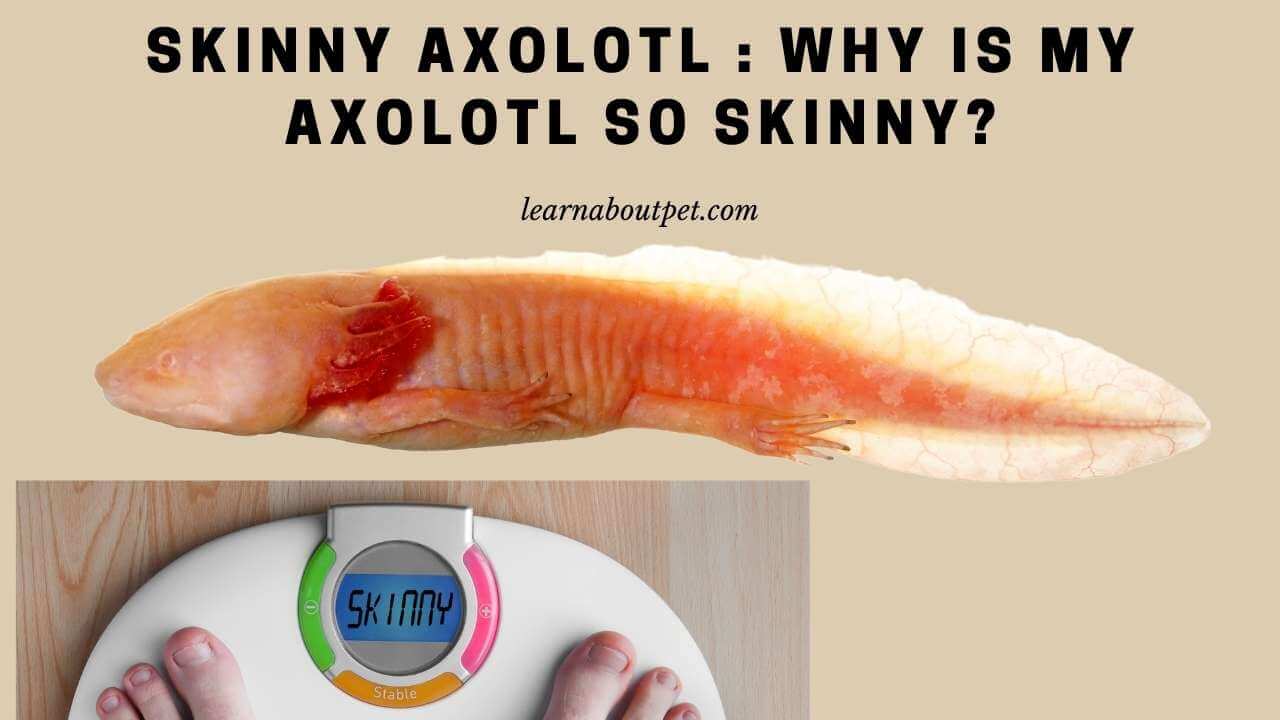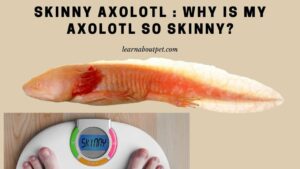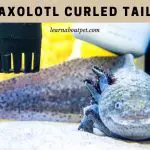Having an aquatic pet like an axolotl is something to be proud of because you are one of those people who want to prevent the Axolotl from becoming extinct. Keeping the Axolotl healthy and living up to its life expectancy is not an easy task. One of the things that should be prevented is the skinny pet Axolotl.
If you see a skinny axolotl with several other symptoms such as shedding slime coat, curled gills, floating, or lack of appetite, there are several possibilities, such as poor water quality in the tank or the Axolotl experiencing stress.
You should know a few things regarding the condition of the Axolotl for this. Let’s read this article until the end.

Is My Axolotl Too Skinny?
The comparison can be seen from the belly and head if you want to compare a skinny axolotl with a normal axolotl. Make sure your Axolotl has a belly that is equal to or larger than its head. If their belly is smaller than their head, then your Axolotl is considered skinny.
The main cause of skinny Axolotl is irregular eating time, or the portion given is still small and does not match the age or size. If you have a baby or juvenile axolotls, you should feed them daily at the appropriate size.
If you give too much, it will result in overeating. Too little will cause skinniness. If your juveniles are already skinny, their growth slows down compared to other axolotls.
Food portions will decrease as they enter sub-adult and adult, with a gap of one or two days before they can be given the next meal. The type of food given to axolotls must also be adjusted because young axolotls are picky in terms of food.
You also have to always look at the tank’s condition because the Axolotl that gets enough food will also produce a lot of waste. If the axolotl tank is dirty, they can get stressed and become one of the causes of skinny Axolotl.
Why Is My Axolotl So Skinny?
The question will spread to other questions such as ‘did your axolotl eat enough?’ or ‘does your axolotl have an infection or parasite?’ because there is a possibility that the skinny Axolotl is due to a disease or infection that makes them not want to eat so they are getting thinner.
If exposed to parasites or infections, ensure axolotls undergo appropriate treatment such as salt baths or fridging until they recover. Feed them a little more than usual, and ensure their digestive system is running normally.
If your axolotls are thin because you rarely feed them, then you should look for information about what food and when to feed the Axolotl. Giving live food to young axolotls is more appropriate because they prefer moving food.
If young axolotls are given pellets or dead prey, their senses still can’t distinguish between food and inanimate objects. When they reach sub-adult, axolotls already have a sharper sense of smelling the food they have often eaten. You can already give them pellets for their regular meal.
Why Is My Skinny Axolotl Not Eating?
You have to find the root cause of this happening. Axolotls will not suddenly lose weight in a short time and refuse the food you give them.
If you have checked the temperature of the water in the tank is appropriate, the water quality is good, and the condition of the Axolotl is healthy, the Axolotl can’t refuse the food you are given.
If you do not pay close attention to the Axolotl for more than two weeks, or if you stay for a long time and are not fed, it could be the main cause of skinny Axolotl.
Axolotls will only be fine and not lose weight even if they are not fed for up to three weeks, provided that beforehand they must be fed regularly and in the right portions.
Do intentionally not feed axolotls because it can affect their metabolism. If the Axolotl is hungry, they can be aggressive. When they have tank mates, they will do fin-nipping or nibbling or even eat smaller fish.
Even axolotls can attack other axolotls. If the larger Axolotl is still bullying the Axolotl that is the victim, they will be less active or eat more, making them skinny. It is recommended to put one Axolotl per tank so that they do not have any competition and can live quietly alone in the tank.
Reasons Why Axolotl Not Eating
In preventing skinny Axolotl, you must prevent several things from happening so that the Axolotl stays healthy or has an ideal body weight.

The table below will show some of the reasons why axolotls won’t eat.
| Reasons | Explanation |
| A new habitat | Axolotls will refuse to eat if they are in a new place. It can take a week or more before the axolotl can accept food. |
| Hot temperature | Axolotl will not cool down if it is in a tank with a temperature above 22°C. This makes the axolotl stressed and refuse to eat. |
| The arrival of winter | During winter axolotls will reduce their diet because their metabolism decreases. |
| Bad quality of food | Pay attention to whether you give spoiled pellets, worms that are starting to rot, or food sizes that are too large for them to swallow. |
| Poor water quality | A high level of ammonia due to too much axolotl waste makes the axolotl not want to eat. |
| Constipation | When the axolotl’s stomach is full from eating too often or eating too much, the axolotl will have trouble passing their stool. |
| Eating gravel | A gravel that has a size that an axolotl can swallow will cause an impaction that can lead to death. |
Although some of the above events do not only happen to skinny Axolotl, these things should still be your concern. Refusing to eat can be the main reason why your Axolotl is skinny.
Skinny Axolotl Symptoms
Several symptoms are very clearly shown by the skinny Axolotl, such as refusing to eat, inactivity, floating, and a smaller stomach than its head.
If the Axolotl’s main problem is a lack of appetite, you need to entice them with their favorite food, hold the food in front of their eyes until they eat it. If this method still doesn’t work, force-feed them though not recommended.
You can do a force-feed by putting moist food in a syringe and slowly inserting it into the Axolotl’s mouth until it runs out. Make sure they don’t spit it out and do it repeatedly in their weekly mealtimes.
If the Axolotl has regained its posture, you can try feeding it regularly without having to use a syringe. First, move the axolotls in a quarantine tub with better water quality than in a tank, and always keep an eye on them while eating and make sure they are finished.
If your Axolotl shows other symptoms, such as floating or shedding its slime coat, your Axolotl is suffering from a disease due to high ammonia or nitrate levels. Do a water test and move the axolotls for fridging until they recover while you clean the water in the tank.
Perform water changes of 20% or more while ensuring that ammonia or nitrate levels are not harmful to the Axolotl.
Can Skinny Axolotls Appear Due To Stress?
Stressed Axolotl begins with curled gills, inactivity and is very lethargic. This will greatly affect the Axolotl’s desire to eat and make their bodies skinny. If you continue to ignore this, the condition of the Axolotl’s body can be even worse than before.
Stress will make the Axolotl’s metabolism unstable, and slowly you will have a skinny axolotl. Do some things that stress axolotls, such as changing the water regularly, giving the Axolotl their favorite food, leaving them alone in the tank, and checking their health every time.
If the Axolotl is always under stress, they can get a more severe disease or lead to death. Caring for axolotls is not difficult. It’s just that they have to meet some requirements. Good water conditions, proper meal every time, and suitable water temperature are the main things to keep the Axolotl healthy.
Does Skinny Axolotl Have A Lot Of Sicknesses?
If you’re new to the skinny axolotl problem, it doesn’t mean they have many diseases right away. But when the Axolotl is skinny, it will be a great opportunity for them to get diseases. However, some diseases make axolotls lose their weight easily.
Very lazy and fewer appetite conditions will make their bodies lack food intake, and their metabolism will not run normally.
While the Axolotl can go without food for three weeks or more, we shouldn’t be relying on it. Feeding them regularly will continue to keep their bodies healthy. Adult axolotls need every two to three days for a proper meal.
You can still do a few things when it comes to underweight axolotls. You can do therapies such as salt baths to treat them if they get infections or parasites, forcing them to eat by using a syringe, and putting the Axolotl in a stress-free place.
If the Axolotl has some symptoms such as swollen belly, pale coloration, or any other severe condition, you need to contact the vet and tell them the condition of your Axolotl for special treatment.
How To Fatten Up Axolotl?
Fatten-up axolotls are required so that they are not susceptible to disease and live according to life expectancy. How to fatten axolotls by changing their diet, but not by giving them larger meals. The frequency of eating is reproduced with portions that are still by what you usually give.
When you do that, you should pay attention to avoid impaction or constipation conditions. When axolotls are constipated, stop feeding them for a few days. Do the fattening process again after the condition of the axolotl recovers.
You can return to the normal portion once the Axolotl’s belly looks a little bigger than its head. It will be easier to do this while you still have young axolotls because this includes speeding up their body development with the healthy food you provide.
How Fat Should Axolotl Be?
The ideal body shape for axolotls is the equivalent shape of the Axolotl’s head and abdomen, with no visible internal organs such as ribs that protrude from their bodies. In addition, healthy axolotls will do more activities in the tank, and when resting, they are at the bottom of the tank.
Axolotls have a strong sense of when you give them food, and they reach it in no time. Never refuse food and respond if you move something in front of them. The healthy adult axolotl size is about 45 cm. A suitable tank for an axolotl of that size is a 20-gallon tank.
Final Verdict On Skinny Axolotl
Providing a healthy life and a pleasant life experience for axolotls will ensure they can become long-lived aquatic pets for you. The problem to avoid when you have an axolotl is being an skinny axolotl due to various reasons.

You can look for several reasons why axolotls refuse to eat and become skinny such as the water condition, the type of food you give them, and their body condition.
If you have found the main problem with axolotls, you can start to entice them to eat until their body shape is ideal. The Ensure axolotl has a belly that is at the level of its head or slightly larger. A healthy axolotl will swim to and fro and have a high sense of live foods you put into the tank.

Welcome to Learn About Pet. My name is Rajkumar Ravichandran and I love all pets, travel, and amazing food. I write about my passion and personal experience caring for multiple pets in this blog! ❤️
Post Disclaimer
DISCLAIMER: THIS BLOG OR WEBSITE, "Learn About Pet", DOES NOT PROVIDE YOU WITH MEDICAL ADVICE AND IS NOT A SUBSTITUTE FOR MEDICAL ADVICE. ALWAYS GET IN TOUCH WITH YOUR PERSONAL VETERINARIAN AND USE INFORMATION HERE AS GENERAL ADVICE.
The information, including but not limited to, text, graphics, images and other material contained on this website are for informational purposes only. No material on this site is intended to be a substitute for professional veterinary advice, food recommendation, diagnosis, or treatment. Always seek the advice of your veterinarian or other qualified health care provider with any questions you may have regarding a medical condition or for pet food related questions.







